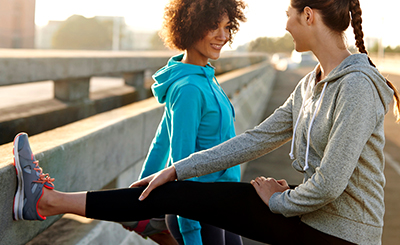What to bear in mind while stretching
A runner is not expected to be able to touch their toes with their fingertips when their legs are outstretched. It has not been proven that people with good flexibility are faster. And yet it is important that stretching is included in every training programme. Why this is so and what a stretching programme for runners should look like, we will show you next.
The struggle against one-sidedness
Running is a cyclical sport. This means that the movements are always the same and the same muscles are constantly stressed. Since running is one of the most natural forms of human movement, those muscles that are also frequently used in everyday life are engaged. This often leads to overload and a lack of recovery time, especially for beginners or ambitious runners. A sensible stretching programme can loosen up these muscle groups and shorten the recovery time.

Reducing tension
Our muscles can contract or relax. Contraction creates tension in the muscle and thus strength. Even at rest, we have a certain tone (tension) in our muscles. Overload while exercising specifically increases the tone. Too much training leads to excessive tone and thus to constant irritation of the muscle and nerve cells. Consequently, these cells are more sensitive than desired, recover more slowly, work less economically and are more susceptible to injury. Stretching is one way to reduce tone after exercise and thus reduce injuries caused by overload. To reduce tone, massage, foam rolling, contrast baths, gentle exercise or sauna sessions can also help.
Staying flexible
Theories and recommendations regarding the benefits or design of flexibility training are always changing. Performance-enhancing effects cannot be clearly established, and stretching is even discouraged in certain situations, such as after intense strength training. However, these are not reasons to eliminate the stretching programme altogether.
After all, experts agree that neglecting flexibility exercises reduces the economy of movement, makes everyday tasks more difficult and increases the risk of injury. So if you want to jog casually through the woods and still tie your running shoes standing up in a few years, you shouldn't skimp on your stretching programme.
From foot to head
Between the start and finish line, the lower part of the body is the main part of the body that is placed under strain during running. Thus, it is obvious where one should focus when doing stretching exercises. However, the muscle groups of the back, abdomen and shoulder girdle should not be underestimated either. To ensure that all relevant muscle groups are included, it is best to perform the exercises muscle by muscle from the bottom to the top. Start with the feet and work slowly upwards until you reach the neck. Hold the positions for 30 to 60 seconds.
The following groups should be focused on:
- Calves
- Front thigh
- Posterior thigh
- Buttocks
- Hip flexors
- Lower back
- Pectoral muscles
- Rear shoulders
- Neck



